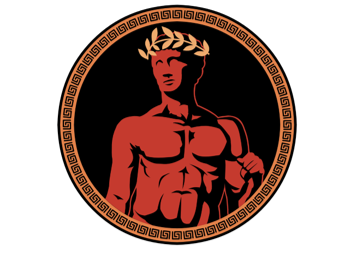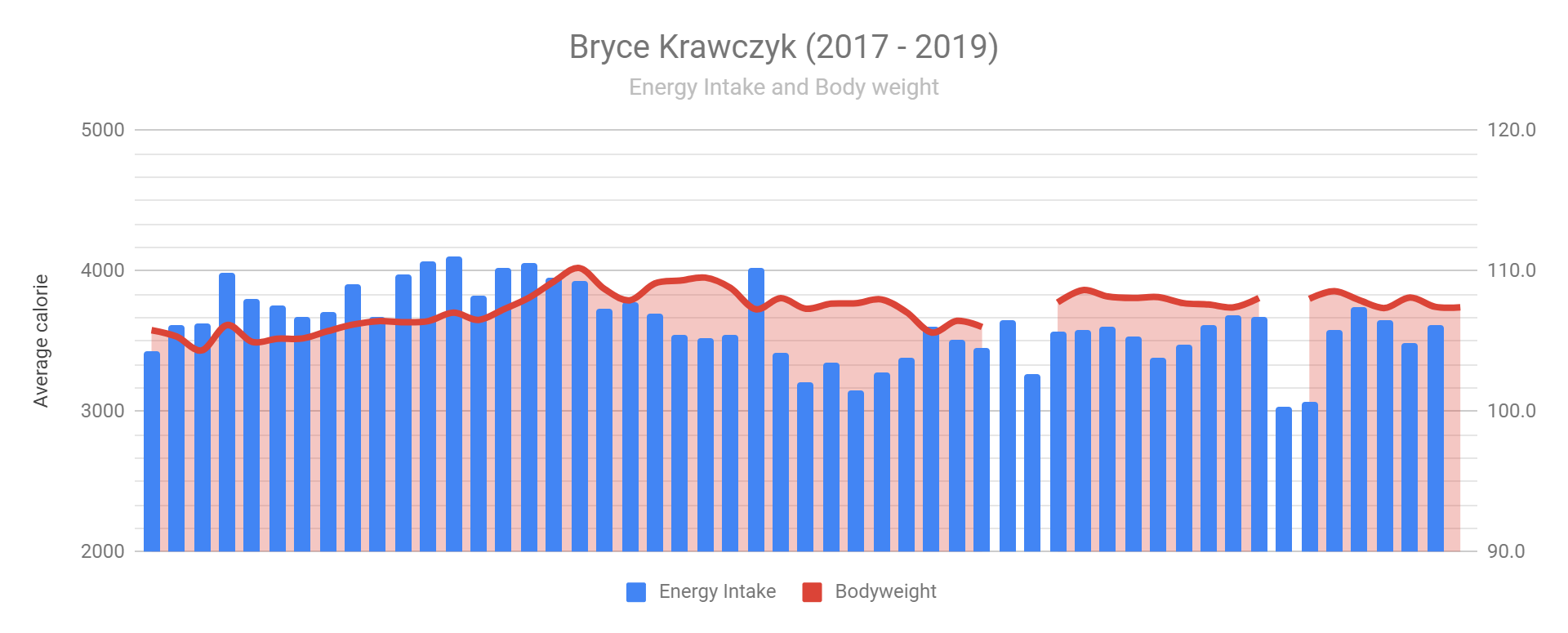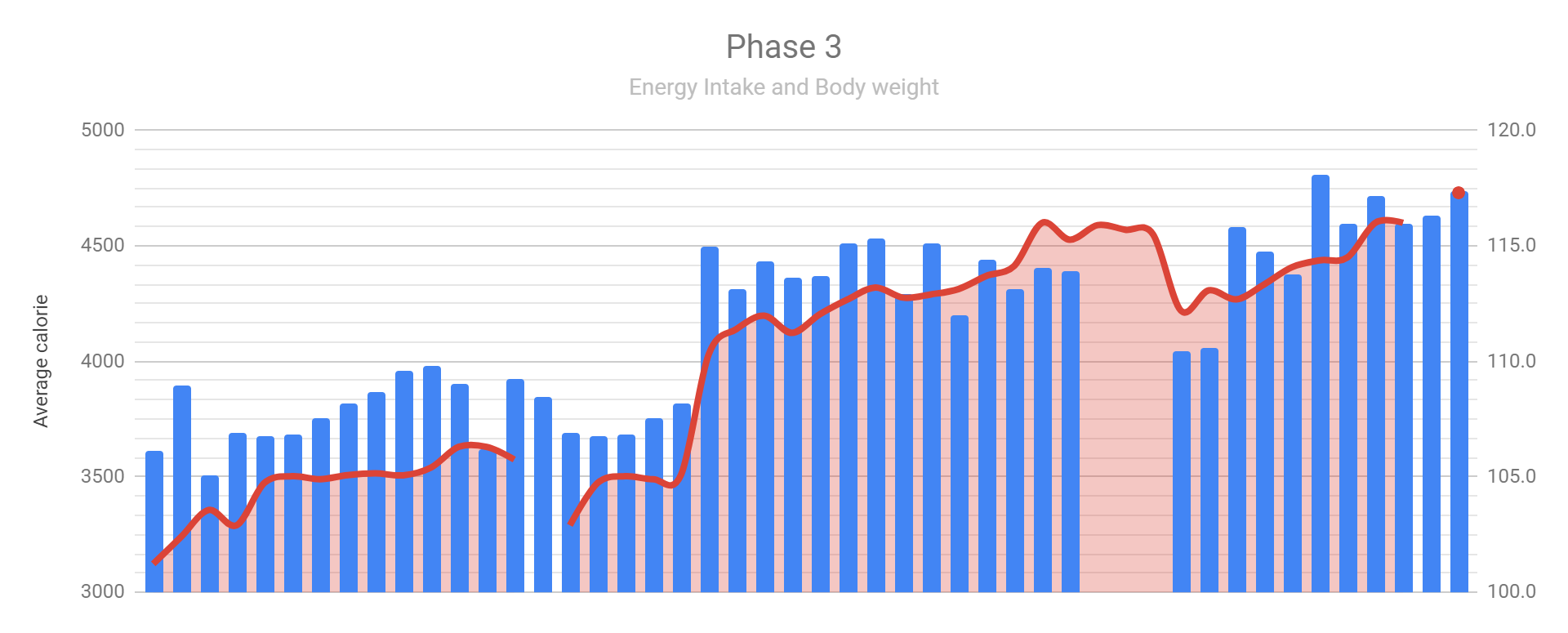|
I have been guiding the nutrition of powerlifter Bryce Krawczyk since 2017. Previous to our work together, Bryce was an accomplished lifter - placing 2nd at the 2016 IPF Classic World Championships. But, like many other good lifters, Bryce had identified nutrition as a missing piece of his process. The goal of this piece is to detail how things have gone since then - the strategies, planning and mindsets we’ve taken to take his lifting and performance to the next level. In my experience, most capable nutrition experts fall into two categories fall into two categories:
In my practice, I try to blend both of these approaches to deliver a comprehensive and practical program. Also, I want to be clear - our work together has been intermittent, there have been times where we took planned time off from this focus (an important and overlooked part of the process). I’m detailing our work together because it’s not often you get to work with a high level athlete over a long period of time and this experience sheds insight into long-term nutrition planning, short term weight manipulation, behaviour and psychology, and weight class strategy. Without further ado: When we started, his nutritional habits were similar to many of my clients:
Immediately, I took into account his normal food habits, assessed how things looked objectively (calories and macronutrients) and set a plan with his weight classes in reference. Then through the years, we started to focus on different phases with different intents to make sure his nutrition reflected his goals, with the overall aim to make him the most competitive strength athlete possible. In each phase, I want to outline what the focus and plan was with his body weight and nutrition, plus what actually happened and what lessons were learned. Phase 1: Optimizing a weight class (2017-2018)FOCUS: With most clients, the goal is to fill out the weight class and be slightly above (making minimal week-of weight manipulations) in the effort to make the athlete bigger than the competition (viable strategy in weight class sports). So In 2017, we started the process of optimizing Bryce’s body weight and body composition within the 105 kg class. The first meet we prepared for was the 2017 CPU National in Quebec. Bryce was getting into equipped lifting and planned to do both contests on back to back days (Friday March 17/Saturday March 18). With the back to back weigh-ins, with one of the contests being equipped, I decided to get him safely in the weight class so he could eat and drink throughout and just as important, his gear fitted similarly in training to how it would on game day. PLAN: SO, for the 5 weeks leading up to the contest we put him on a slight deficit and took him from 106 kg to ~103 kg the week of the contest. We would then find the highest level of food that would put him closer to maintenance levels and keep him within striking range of 105 kg. OUTCOME: Even with the initial weight loss, Bryce performed well in training and generally felt better. Probably due to the increases in protein and food quality. We actually got a bit ahead of the process and we are able to ramp his carbs up leading into the week of the meet. Bryce was able to make weight both times (103.8 first, 103.1 raw second) and win both weight classes with 898 and 797.5 kg totals respectively. PB in the equipped meet. Past this time, Bryce was able to maintain between 105 - 109 kg (0-2.5% above weight class - something I detail more fully in the "Way of the Weigh-In") for a full 18 months leading into some other premier events: IPF Equipped World Championships 2017, CPU Nationals 2018, and IPF Classic World Championships 2018 all in the 105 kg class. His energy intake ranged between ~3300 - 3600 kcal for the most part, but one of the biggest changes was his dedication to protein intake (~230-250 grams) down the stretch. Additionally, there were two local meets and the Arnold invitational in this time where we decided to lift as is (~108 kg) to meet qualifiers or focus solely on performance without short term weight manipulations. The decision to make a weight class should really depend on the goals for your event - determining the aim and being realistic about what’s going on (Arnold two weeks after 3-lift Nationals etc) in your life and training. CLIFF NOTES:
Phase 2: Pushing the leanness (2018)FOCUS: Intent is always important - sometimes it means maintaining your weight, but it can also mean changing focus into fat loss or muscle gain (and subsequent weight changes) to improve as a strength athlete. After the 2018 Classic Worlds, Bryce wanted a change so after a bunch of beers we decided to go into a fat loss phase to re-optimimize his body comp. NOTE: He wanted to get leaner - I wanted to move Connor, Bryce and myself into the same training/housing compound (“the brodome”) where Dillon would document us getting as shredded as possible. PLAN: We decided to push for ~100 kg from 108-109 over a 3-4 month period. Based on the past phases, I knew a ~10% calorie drop over this period should do the trick. OUTCOME: Bryce transitioned to eating lower levels of food - focusing on food volume and hitting his protein targets. His energy intake got as low as ~2700 kcal per day, as weight got closer to 102-103, then past that point we were able to start ramping things up as he got more active and weight dropped as low as 100 kg while eating more (3200-3500 kcal). CLIFF NOTES:
Phase 3: CREATING THE ULTIMATE LUNCH LADY (2019)FOCUS: After the cut, we worked his food intake up to fill 105 kg back in and he lifted at 2019 CPU Nationals in the 105 kg class. At a certain point, the best way for a strength athlete to improve their strength is to fill in a heavier weight class - so the decision was made to work up into the 120 kg class. This was one part necessity - at a certain level, eating near maintenance levels would hinder the potential to get strong and hit some lifelong milestones. But additionally, the competition level was more favourable in the -120 kg class at the International level. So we decided to take the plunge and join the big boys (read not biggest boys) a weight class up. PLAN: In most cases, quality weight doesn’t go on as fast as less favourable weight comes off, we wanted to make the slow climb up to 115-116 so Bryce was near the top of the class, but given his deadlifting advantage could always tie competitors and come up on top (being one of the lighter competitors). But, in my experience lifters don’t just hang out in the middle of the weight class. For whatever reason, once you decide to go up, you just go up and 109 turns into 114 in what feels overnight. Part of this is intended, but the other part is subconscious (more relaxed around tracking/controlling). OUTCOME: Gaining a bunch of weight isn’t as easy or fun as it sounds. Since we were a bit more relaxed around tracking (i.e taking 2-3 days off per week) we used a few strategies to keep Bryce moving in the right direction. The first one was setting a basement level of calories - we always try to stick within ranges, but the “basement” is a better visual for most clients. Don’t go under this, you need to make it here. Thus the basement was set at 4,000 calories and Bryce knew to keep pushing he would need to get there each day. To me the goal of consistency isn’t being perfect each day, but a bunch of good days all strung together. #nodaysunder4K On the off days, his only goal was not to come back into normal routine weighing any lighter. This set the intent for his eating. Lastly, to eat 4000+ kcals each, you need to eat some less healthy food to get there (candy, higher fat meat). It left Bryce feeling rather sluggish and unwell, so we set some structure around food choices that would help improve his overall health and well-being. It looked like this: 1) Include 1 serving of fruit or vegetable every time you eat 2) Include 1 anti-inflammatory fat source every time you eat (minus pre-workout meals, just to help digestion). Think nuts, seeds, trail mix, hummus, olive oil, coconut oil and chips, fish etc. This was a big game changer in the way Bryce viewed his nutrition. CLIFF NOTES:
SUMMARYWorking with anyone, let alone a high-caliber athlete like Bryce, for years is a privilege. You get to put some long term planning into action and flex your behavioural change muscles to keep things moving. Some of the biggest lessons from this period are:
24 Comments
Joe
4/7/2020 02:06:16 pm
Great article! I enjoyed the read. In the context of a non-professional intermediate lifter who’s 20ish% bf, with powerlifting goals, do you think a recomp approach would work? There are a lot of conflicting views on whether a classic bulking and cutting approach vs just maintaining weight and focusing on getting stronger, thereby recomp, is a more optimal approach in this scenario.
Reply
4/9/2020 08:39:10 am
Glad you enjoyed it.
Reply
Adrik
11/6/2023 07:23:49 pm
I couldn't believe the incredible results with this product. From 85kg to a stunning 55kg, I feel more energized and healthier. <a href="https://ed7c2rw9mblgivchyqp1o5sa65.hop.clickbank.net" target="_blank">click here</a> to discover the power of this life-changing product!
Nitesh josh
6/11/2024 07:53:27 pm
I was skeptical, but this weight loss product surprised me. From 95kg to a stunning 65kg, it truly delivered remarkable results. Ready to transform your weight? <a href="https://749813kdlez6cnaazaky5vdm4l.hop.clickbank.net" target="_blank">click here</a> to get started!
Reply
jahn mac
7/8/2023 09:34:02 pm
Your blog post was a thought-provoking exploration of the topic. I appreciated the way you highlighted different perspectives and encouraged critical thinking. To delve deeper into this subject, <a href="https://bio.link/fastfatloss" target="_blank">click here</a>.
Reply
Andrew
7/23/2023 03:39:36 am
This weight loss product is a true game-changer. It helped me shed an incredible 60kg, going from 130kg to 70kg. Don't miss out on the opportunity to transform your life. <a href="https://digi.hormonalbalancenow.com/#aff=Biswanath424" target="_blank">click here</a> to order and take the first step towards a healthier future!
Reply
jahn
7/31/2023 06:43:51 am
This product was my lifeline when it came to weight loss. Going from 85kg to a stunning 55kg, it gave me a new lease on life. Don't let excess weight hold you back any longer - <a href="https://294cchw9sbn92ue0m5zbaofmei.hop.clickbank.net/?cbpage=quiztraditional" target="_blank">click here</a> to discover the secret to a slimmer and healthier you!
Reply
gautam
8/4/2023 05:43:24 am
This product was my last hope for losing weight, and it delivered amazing results. Going from 85kg to a stunning 60kg, I'm now full of energy and confidence. <a href="https://www.digistore24.com/redir/382628/gautam3372/" target="_blank">click here</a> to start your journey to a healthier lifestyle!
Reply
8/6/2023 06:52:36 pm
"Your acts of kindness and selflessness make the world a brighter and better place."
Reply
jahn
8/7/2023 07:15:46 am
Thanks for sharing your knowledge. To gain a more in-depth understanding, <a href="https://294cchw9sbn92ue0m5zbaofmei.hop.clickbank.net/?cbpage=quiztraditional" target="_blank">click here</a> for further insights.
Reply
jahn
8/7/2023 06:39:34 pm
Thank you for providing such an informative and well-structured blog post. The content was easy to follow, and I appreciated the additional resources you shared. To explore further, <a href="https://294cchw9sbn92ue0m5zbaofmei.hop.clickbank.net/?cbpage=quiztraditional" target="_blank">click here</a>.
Reply
Angel
8/25/2023 12:50:10 am
This product is not just a weight loss supplement; it's a life-changer. From 130kg to 80kg, it has transformed my life in ways I never imagined. <a href="https://www.digistore24.com/redir/466836/Kamalsrivastava/" target="_blank">click here</a> to change your life too!
Reply
Michael Jack
9/12/2023 12:19:24 am
This product is a true life-saver! From 130kg to 80kg, it has been a life-transforming experience. <a href="https://378d6id0prr110g5q3z7kbayfu.hop.clickbank.net" target="_blank">click here</a> to change your life for the better!
Reply
RAYMOND
9/24/2023 02:40:50 pm
I couldn't be happier with the results I achieved with this product. It helped me go from 110kg to a fit and fabulous 70kg. Join me on this journey by <a href="https://e3ae2yjjqbhs9ofdwgtmuccldo.hop.clickbank.net" target="_blank">click here</a> and embracing a healthier lifestyle!
Reply
Rubio Laura
10/5/2023 03:39:49 am
"Wow, I am genuinely amazed by the incredible changes I've experienced since embarking on my weight loss journey with this program! 😊 I discovered this fantastic website a few weeks back, and I've already shed 10 pounds! The personalized meal plans and workout routines are so user-friendly, and the support from the community is incredibly motivating. I never imagined I could reach my weight loss goals, but this program has made it possible for me. I highly recommend giving it a try if you're seeking a positive transformation in your life! You can find more information at https://o-trim.co/ipbBN3 🌟 #WeightLossJourney #HealthyLiving #LovingMyBody"
Reply
Smith Jhon
10/6/2023 10:04:28 pm
Losing weight felt impossible, but this incredible product made it happen. From 85kg to a lean 60kg, I'm full of energy and confidence. Take charge of your weight - <a href="https://a1858ixxsqjo8zevmit7u7tv5s.hop.clickbank.net" target="_blank">click here</a> to order and embrace a new you!
Reply
Peter
10/11/2023 02:37:42 am
This weight loss product is a true game-changer. It helped me shed an incredible 50kg, going from 130kg to 80kg. Say goodbye to excess weight and hello to a healthier you! <a href="https://4ca0c7d0zxc4cnccyl2hwcbpfy.hop.clickbank.net" target="_blank">click here</a> to begin.
Reply
Joseph
10/11/2023 07:10:49 am
https://www.google.com/url?sa=t&source=web&rct=j&opi=89978449&url=https://www.liver.ca/blog/nutrition-cirrhosis-guide/&ved=2ahUKEwisiNWu--2BAxWumlYBHY0NAXM4ChAWegQICxAB&usg=AOvVaw2Kx3_-KpaVsVLpSJEeGk5X
Reply
Adrik
11/6/2023 07:24:30 pm
I couldn't believe the incredible results with this product. From 85kg to a stunning 55kg, I feel more energized and healthier. <a href="https://ed7c2rw9mblgivchyqp1o5sa65.hop.clickbank.net" target="_blank">click here</a> to discover the power of this life-changing product
Reply
Losing weight had always been a struggle, until
Reply
Jayanta Roy
2/7/2024 05:35:37 am
This product is the secret to my weight loss success. It helped me shed an impressive 35kg, going from 100kg to a healthy 65kg. Don't wait any longer - <a href="https://7c796kn852rkgy29tkqg5d2wdp.hop.clickbank.net" target="_blank">click here</a> to order now and see the difference!
Reply
Max
3/26/2024 10:23:14 pm
Say goodbye to the weight that's been holding you back! This incredible product helped me drop from 105kg to a fit 65kg. <a href="https://leanbliss24.com/text.php#aff=Suneelmax2" target="_blank">click here</a> to embark on your journey towards a healthier lifestyle!
Reply
Joe
4/1/2024 10:51:26 am
Losing weight had always been a struggle, until I discovered this remarkable product. From 75kg to a lean 55kg, I feel like a brand-new person. <a href="https://lavaslim.co/#aff=parshastri3" target="_blank">click here</a> to begin your journey to a healthier you!
Reply
Leave a Reply. |
Marc Morris PhD CSCS Dr. Marc is an online nutrition and strength coach. Marc leverages his athletic experience and credentials in biochemistry and human nutrition to provide evidence-based but practical recommendations to clients and the fitness community. Archives
February 2022
Categories |
Services |
Company |
|
|
© POLYHEALTH NUTRITION AND FITNESS INC. 2021. ALL RIGHTS RESERVED.
|
Website Design by My Personal Trainer Website
|







 RSS Feed
RSS Feed